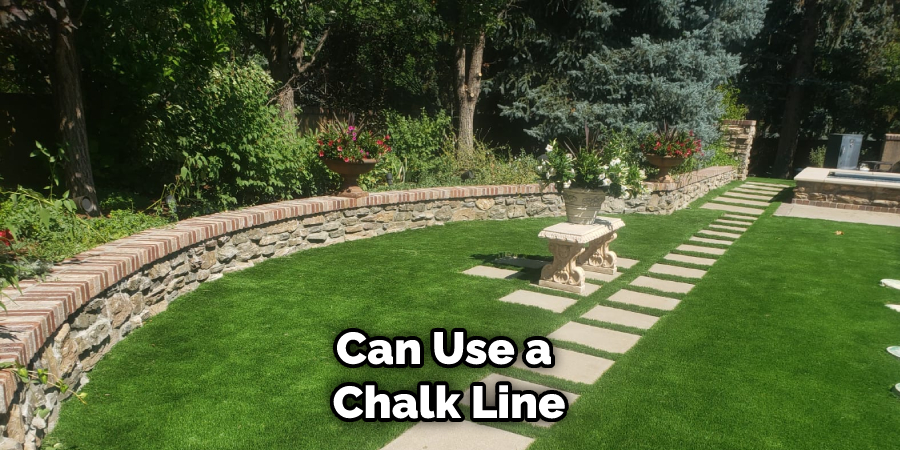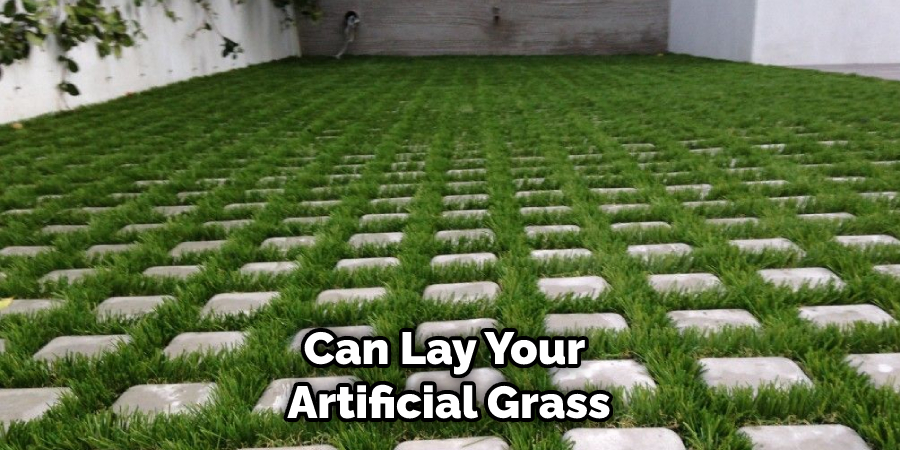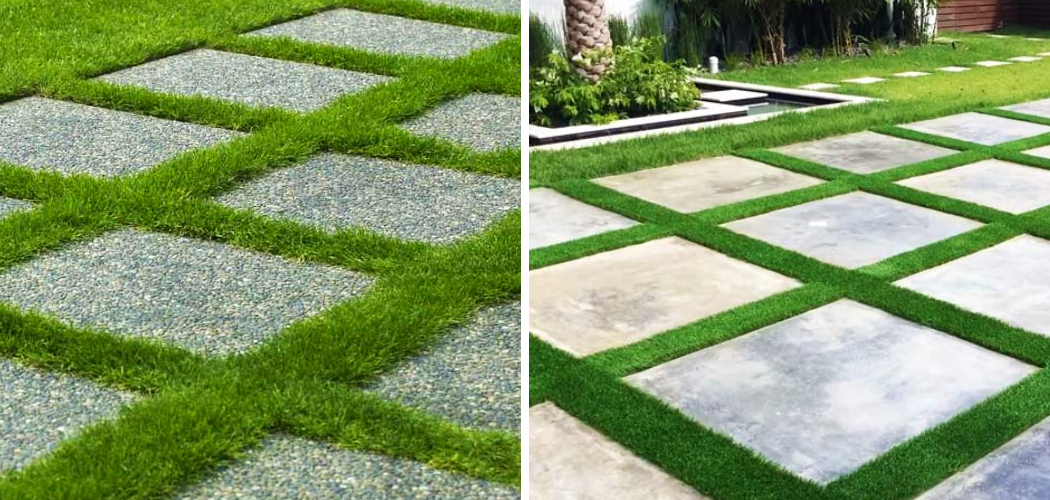
Are you looking to spruce up your outdoor living space with some artificial grass? The good news is that you can install artificial grass strips between pavers, creating a seamless and attractive look.
Installing artificial grass strips between pavers is a great way to spruce up any landscape effortlessly.
Not only is it an aesthetically pleasing addition, but it’s also incredibly easy to do and won’t cost you a fortune, either! In this blog post, we’ll discuss everything you need to know about adding artificial grass between pavers, including supplies needed, installation steps, and best practices for maintenance.
So if you’re ready for a yard makeover without having to invest time and money into heavy renovation or maintenance projects, read on for our step-by-step guide on how to install artificial grass strips between pavers.
What Will You Need?
Before you get started on your artificial grass installation, it’s important to make sure that you have all the necessary materials and supplies. The most important item is the artificial grass strips – these come in various colors and widths, so take some time to find the best match for your outdoor space.
In addition to the artificial grass strips, you’ll need a few tools:
- Power drill
- Landscape fabric
- Sand
- Weed barrier cloth
- Utility knife
- Masonry trowel
- Seaming tape or adhesive (optional)
Once you’ve gathered all your supplies, you’re ready to start installing your artificial grass strips between pavers!
10 Easy Steps on How to Install Artificial Grass Strips Between Pavers
Step 1. Mark Off the Area:

Using a measuring tape, mark off the area where you’ll install your artificial grass. You can use a chalk line, flags, or other markers to indicate where the turf will go. Be careful to measure out an area that’s slightly larger than the artificial grass strips. You’ll need this extra space to account for any excess.
Step 2. Dig out the Area:
Using your trowel or shovel, dig out the marked-off area to a depth of 1-1/2 inches. Make sure you remove all existing grass and weeds to have a clean surface for your turf installation. Removing large rocks or stones that may disrupt the artificial grass installation is also important.
Step 3. Lay Down Landscape Fabric:
Cover the entire digging area with your landscape fabric, spreading it evenly over the surface. This will help protect against weeds growing up through your artificial grass strips. Don’t forget to overlap each piece of fabric by at least 6 inches.
Step 4. Install Weed Barrier Cloth:
Lay down your weed barrier cloth over the landscape fabric to further protect against weed growth between pavers and artificial grass strips. Secure the barrier cloth in place with stakes or pins. Use a utility knife to cut away any excess fabric.
Step 5. Install Pavers:
Start installing your pavers from the corner of the area and work your way outwards. You can use a rubber mallet to help set them into the ground and ensure they are level. Make sure to leave a 1/4-inch space between each paver for drainage purposes.
Step 6. Fill Gaps Between Pavers:
Fill any gaps between your pavers with sand, ensuring they’re even and level with one another. This will also provide added stability and support for your artificial grass strips when you install them later on. Additionally, it will help keep the pavers in place and prevent them from shifting over time.
Step 7. Install Artificial Grass Strips:

Now it’s time to install your artificial grass strips. Start from one corner of the area and work your way out, making sure that each strip fits snugly against its neighbor with no gaps in between. You can use seaming tape or adhesive to hold them together if necessary.
Step 8. Cut Away Excess Grass:
Using a utility knife, trim away any excess grass at the edges of your installation area to make it look neat and tidy. Don’t worry if there’s some overhang – this will help provide protection against foot traffic wear and tear later on. Another option is to use a specialized edging material to frame the artificial grass strips.
Step 9. Fill Gaps Between Artificial Grass Strips:
Fill any small gaps between the strips of artificial turf with sand, making sure they’re level with one another. This will help keep the turf in place and provide extra stability against foot traffic later on. Ensure that all gaps are filled before moving on to the next step.
Step 10. Enjoy Your New Artificial Grass Installation:
Once you’ve finished installing your artificial grass strips, remove any flags or markers that you used to indicate where the turf would go. Then, sit back and enjoy your newly installed artificial lawn! With minimal upkeep, it should last for years of enjoyment.
Now that you know how to install artificial grass strips between pavers, you can finally get your outdoor space looking like a professional landscaper’s dream! Whether it’s for a garden path, patio area, or other decorative elements – adding some lush green artificial grass is sure to bring some life to your outdoor space.
With just a few steps and the right materials, you can have a beautiful artificial lawn that requires little maintenance.

5 Additional Tips ad Tricks
- Make sure that the area between the pavers is completely level and even in order to prevent water pooling.
- Lay down a weed barrier fabric to help prevent weeds from growing up through your artificial grass strips.
- If you are installing large sections of turf, use heavy-duty staples along the edges of each section to keep it securely in place.
- Make sure to clean any dirt or debris off your pavers before laying down the artificial grass strips so they will adhere properly.
- Use an adhesive specifically designed for outdoor surfaces when adhering the turf strips to the pavers – make sure to follow instructions on how much adhesive should be used and how long it needs to dry before heavy foot traffic can be applied to the area.
With these tips and tricks in mind, you should have no problem installing artificial grass strips between your pavers. Enjoy your beautiful new outdoor space!
5 Things You Should Avoid
- Don’t let the artificial grass strips get too close to the pavers. The pavers can cause damage or discoloration to the grass between pavers over time if it’s not kept at a safe distance.
- Don’t use glue for installation; artificial grass needs to be staked in place, not glued down.
- Avoid letting dirt and debris build up between grass strips and pavers, as this will inhibit drainage and air circulation.
- Don’t rush through the installation process – take your time to ensure that everything is done properly and securely.
- Don’t forget to trim any excess length from the edges of the artificial grass so that it looks neat and tidy when installed between your pavers!
- By following these how-to instructions and avoiding the common pitfalls, you’ll be able to install artificial grass between pavers like a pro! Enjoy your freshly installed lawn and bask in how great it looks!
After installation, your new artificial lawn will require little upkeep. With just a bit of care and attention, you’ll enjoy your new outdoor space for years to come!
Do You Need a Membrane Under Artificial Grass?
If you are laying artificial grass between pavers, it is recommended that you lay a membrane underneath the turf. This will stop weeds from growing up through the cracks and help keep the artificial turf firmly in place and provide extra stability against foot traffic.
Membranes also create a barrier between the ground and the artificial grass, which helps prevent moisture build-up and drainage issues, keeping your lawn looking great for longer.
Choose a breathable, permeable membrane that allows air and water vapor to pass through while still preventing weeds or other plants from pushing their way up through any gaps in the turf.
You may need to use several layers of this material depending on how big your area is – make sure to follow the manufacturer’s instructions for how many layers are required.

Once you’ve laid the membrane, you can lay your artificial grass strips and secure them with staples.
Conclusion
Installing artificial grass between pavers is a great way to add some extra vibrancy and life to your outdoor space. With a few easy steps, you can create an aesthetically pleasing look with minimal effort.
Whether it’s for aesthetic reasons or practical reasons – like helping drain water away from paving stones – artificial grass strips are the path to fantastic looking and easy-to-maintain landscaping for your patio or garden. If you don’t feel up to the task, plenty of professionals can help get it done right.
Hopefully, the article on how to install artificial grass strips between pavers will help you make the most of your outdoor space. So enjoy the beauty of artificial grass alongside your pavers, and don’t worry about maintenance!
You Can Check It Out to to Remove Pavers and Replace With Grass
About
Outdoor Fixes is a distinguished figure in the world of Diy design, with a decade of expertise creating innovative and sustainable Diy solutions.
His professional focus lies in merging traditional craftsmanship with modern manufacturing techniques,
fostering designs that are both practical and environmentally conscious. As the author of diy,
outdoorfixes delves into the art and science of outdoorfixes-making, inspiring artisans and industry professionals alike.
Education RMIT University
(Melbourne, Australia) Associate Degree in Design (Outdoor Fixes) Focus on sustainable design, industry-driven projects,
and practical craftsmanship. Gained hands-on experience with traditional and digital manufacturing tools, such as CAD and CNC software.
Nottingham Trent University
(United Kingdom) Bachelor’s in outdoorfixes.com and Product Design (Honors) Specialized in product design with a focus on blending creativity with production
techniques. Participated in industry projects, working with companies like John Lewis and Vitsoe to gain real-world insights.
Publications and Impact
In diy, Outdoor Fixes his insights on indoor design processes, materials, and strategies for efficient production.
His writing bridges the gap between artisan knowledge and modern industry needs, making it a must-read for both budding designers and seasoned professionals.

